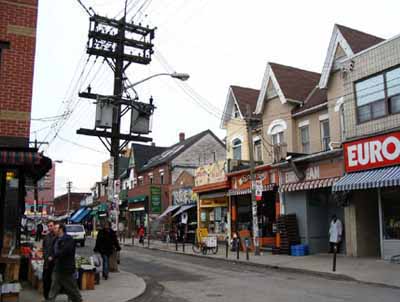Kensington Market National Historic Site of Canada
Toronto, Ontario

General view
© Agence Parcs Canada / Parks Canada Agency, A. Waldron, 2005.
Address :
Dundas West, Bellevue, Spadina, College Streets, Toronto, Ontario
Recognition Statute:
Historic Sites and Monuments Act (R.S.C., 1985, c. H-4)
Designation Date:
2006-11-27
Dates:
-
1815 to 1815
(Construction)
Event, Person, Organization:
-
George Taylor Denison
(Builder)
Other Name(s):
-
Kensington Market
(Designation Name)
Research Report Number:
2005-030, 2008-CED-SDC-004
Plaque(s)
Existing plaque: north side of Bellevue Square near Augusta Avenue Dundas West, Bellevue, Spadina, College Streets, Toronto, Ontario
For generations, people of diverse origins have lived and worked along the narrow streets of this colourful and distinctive neighbourhood. In the mid- 19th century these streets were laid out over the Denison family estate. The tightly knit blocks of businesses, homes, and community institutions evolved as successive waves of immigrants, attracted by the relative affordability of the area, added their cultural imprint to the city. The district was first occupied by British workers, then by Jewish immigrants who converted the Victorian houses into small family-run stores by adding makeshift ground-floor shops. As a result, the area was known for decades as the Jewish market. After the Second World War, new Canadians from Italy, Portugal, Eastern Europe, the Caribbean, and Asia were drawn here, each in turn adding to the vibrant life of this culturally diverse marketplace. Tolerance and integration have been vital to the development of this cosmopolitan community, which is distinguished by constant renewal. Filled with scents and sounds from around the world, Kensington Market recalls the history of the Canadian urban immigrant experience in the 20th century.
Description of Historic Place
Kensington Market National Historic Site of Canada is a small neighbourhood located west of Spadina Avenue in the heart of downtown Toronto, Ontario. Similar to many urban ethno-cultural communities in downtown Toronto, Kensington Market forms a part of this larger area of residential, institutional and commercial buildings. Within the boundary is a vibrant commercial and residential neighbourhood with distinctive narrow streets of small stores with colourful awnings built onto former homes selling food, spices and clothes from around the world. Behind and beside the storefronts there are discreet back alleyways winding through the neighbourhood where short rows of small late-19th century cottages sit on narrow lots. Streets in the district are mostly made up of mixed-use buildings, typically containing a ground-floor store, extending out towards the street, with apartments on the second storey. Most of the buildings date from the 1880s to the 1960s, and have heavily modified fronts, either re-clad by owners or redesigned in a variety of offbeat personal and cultural tastes, reflecting the eclectic milieu of Kensington. Official recognition refers to the entirety of the 27-hectare neighbourhood.
Heritage Value
Kensington Market was designated a national historic site of Canada in 2005 because: it has been home to numerous successive waves of ethnocultural communities who have immigrated to Toronto since the beginning of the 20th century; it is a microcosm of Canada's ethnic mosaic, where many different ethnocultural communities, searching for an affordable home, have each added to the market's layers of cultural variety, maintained a dynamic, culturally diverse market, and contributed to a vibrant street life; and, its network of narrow streets and alleyways fronted by closely built rows of small, narrow houses many of which have been converted to commercial use by the addition of makeshift ground-floor shops and by small-scale purpose-built stores and cultural institutions such as the Kiever and Anshei Minsk synagogues collectively create a distinctive urban district.
The area that is currently Kensington Market was first developed in 1815 by George Taylor Denison who constructed Bellevue Estate on a 40- hectare (100-acre) parcel of land west of Spadina Avenue. In the 1850s and 1860s, the Denison’s gradually subdivided the land and sold it to British and Irish immigrants. As the urban density increased, workers built small cottages along the many laneways. In the early 20th century, Kensington saw an influx of Jewish immigrants, mostly from Russia and eastern and south-central Europe. Over the next thirty years, they established its dynamic character as a market. In the 1920s and 1930s, in response to growing competitiveness, the shops extended even farther out onto the already narrow streets. Canopies and outdoor stalls reached the street and additions were built onto many of the houses to provide more shop space. Beginning in the 1950s, Kensington Market hosted an increasingly diverse cultural mosaic of ethnic groups, races and religions. This included post-war immigration from Eastern Europe, Portugal and Italy. In the 1960s a considerable number of Afro-Caribbean, Chinese and East Indian businesspeople moved into the neighbourhood and opened up shops. The diverse character of Kensington Market’s history has created a continually evolving cultural and architectural environment that remains evident in the market area today.
Source: Historic Sites and Monuments Board of Canada, Minutes, November 2005.
Character-Defining Elements
Key elements contributing to the heritage value of this site include: its location in the heart of downtown Toronto, Ontario; the relationships between buildings, structures, sites, objects and spaces that continue to exist where they were first created; the eclectic variety of architectural styles and types of the 1880s to 1960s period, illustrated by the variety of roof types, window and door openings, mouldings and surfaces; the extended shops, built onto the principal façades of older, predominantly Victorian, row houses; the variety of materials of both a permanent and make-shift character, including brick, wood, glass, ceramic, metal and modern composite materials; and the variety of colours and surface treatments; the low-rise buildings in combination with great urban density; the dynamic balance between continuity and change in the pattern of usage; the existence of specific nodes of interest, such as the synagogues and parks; its continued use as a culturally diverse marketplace.